Dynamic Integrated Ecological Assessment along the Corridor of the Sichuan–Tibet Railway
Abstract
1. Introduction
2. Study Area and Datasets
2.1. Study Area
2.2. Data Source and Processing
3. Methods
3.1. Land Ecological Evaluation System Establishment
3.2. Land Use/Land Cover Transfer Matrix
3.3. Determination of Evaluation Factor Weights
3.3.1. The Analytic Hierarchy Process (AHP)
3.3.2. The Entropy Weight Method
3.4. PSR-TOPSIS Model
3.5. Diagnostic Model of the Ecological Factors
3.6. Land Ecological Evaluation Index
3.7. Grades of Integrated Land Ecological Index
4. Results
4.1. Land Use/Land Cover Change
4.2. Changes in Surface Vegetation
4.3. Environmental Changes
4.4. Changes in Land Ecological Security
4.4.1. Land Ecological Security Analysis
4.4.2. Analysis of the Selected Ecological Factors
4.5. Integrated Land Ecology along the STR
4.6. Accuracy Verification
5. Discussion
5.1. Spatial Distribution of Land Ecology and Its Influencing Factors
5.2. Policy Implications
5.3. Impact of Land Ecological Quality on Species Types
5.4. Limitations and Future Research Perspectives
6. Conclusions
Author Contributions
Funding
Data Availability Statement
Conflicts of Interest
References
- Sowińska-Świerkosz, B. Application of surrogate measures of ecological quality assessment: The introduction of the Indicator of Ecological Landscape Quality (IELQ). Ecol. Indic. 2017, 73, 224–234. [Google Scholar] [CrossRef]
- Stefanidis, K.; Dimitrellos, G.; Sarika, M.; Tsoukalas, D.; Papastergiadou, E. Ecological Quality Assessment of Greek Lowland Rivers with Aquatic Macrophytes in Compliance with the EU Water Framework Directive. Water 2022, 14, 2771. [Google Scholar] [CrossRef]
- Halder, S.; Bose, S. Ecological quality assessment of five smart cities in India: A remote sensing index-based analysis. Int. J. Environ. Sci. Technol. 2023, 21, 4101–4118. [Google Scholar] [CrossRef]
- Karimi, B.; Maron, P.A.; Chemidlin-Prevost Boure, N.; Bernard, N.; Gilbert, D.; Ranjard, L. Microbial diversity and ecological networks as indicators of environmental quality. Environ. Chem. Lett. 2017, 15, 265–281. [Google Scholar] [CrossRef]
- Adebayo, T.S.; Özkan, O. Evaluating the role of financial globalization and oil consumption on ecological quality: A new perspective from quantile-on-quantile granger causality. Heliyon 2024, 10, e24636. [Google Scholar] [CrossRef] [PubMed]
- Ahakwa, I.; Tackie, E.A. Natural resources as a double-edged sword towards ecological quality: Can environmental regulations and green human capital rectify the adverse impacts? J. Clean. Prod. 2024, 457, 142436. [Google Scholar] [CrossRef]
- Oduor, N.A.; Munga, C.N.; Imbayi, L.K.; Botwe, P.K.; Nyanjong, E.O.; Muthama, C.M.; Mise, N.A.; Moosdorf, N. Anthropogenic nutrients and phytoplankton diversity in Kenya’s coastal waters: An ecological quality assessment of sea turtle foraging sites. Mar. Pollut. Bull. 2024, 199, 115897. [Google Scholar] [CrossRef] [PubMed]
- Veríssimo, H.; Neto, J.M.; Teixeira, H.; Franco, J.N.; Fath, B.D.; Marques, J.C.; Patrício, J. Ability of benthic indicators to assess ecological quality in estuaries following management. Ecol. Indic. 2012, 19, 130–143. [Google Scholar] [CrossRef]
- Guo, J.; Cui, Y.; Xu, W.; Shen, W.; Li, T.; Yi, S. A novel friction weakening-based dynamic model for landslide runout assessment along the Sichuan-Tibet Railway. Eng. Geol. 2022, 306, 106721. [Google Scholar] [CrossRef]
- Zhang, D.; Sun, Z.; Fang, Q. Scientific problems and research proposals for Sichuan–Tibet railway tunnel construction. Undergr. Space 2022, 7, 419–439. [Google Scholar] [CrossRef]
- Chen, Y.; Zhang, T.; Zhou, X.; Li, J.; Yi, G.; Bie, X.; Hu, J.; Wen, B. Ecological sensitivity and its driving factors in the area along the Sichuan–Tibet Railway. Environ. Dev. Sustain. 2023. [Google Scholar] [CrossRef]
- Chen, S.Y. Research Progress on Land Ecological Assessment. Agric. Dev. Equip. 2020, 2, 42+52. [Google Scholar] [CrossRef]
- Liu, J.; Zhou, L.; Xi, X. Land ecological quality and its change trend prediction in the Yellow River Basin from 2000 to 2020. Arid Land Geogr. 2023, 46, 1654–1662. [Google Scholar]
- Zhang, Z.; Wu, F.; Wang, J.; Zhang, B. Progress of land ecological evaluation. J. Northwest For. Coll. 2005, 4, 104–107+111. [Google Scholar]
- Messing, I.; Hoang, M.H.; Chen, L.-D.; Fu, B.-J. Criteria for land suitability evaluation in a small catchment on the Loess Plateau in China. Catena 2003, 54, 215–234. [Google Scholar] [CrossRef]
- Rapport, D.; Friend, A. Towards a Comprehensive Framework for Environmental Statistics: A Stress-Response Approach; Statistics Canada: Ottawa, ON, USA, 1979; pp. 11–510. [Google Scholar]
- Concepts and Methods of Environment Statistics: Statistics of the Natural Environment—A Technical Report; United Nations: New York, NY, USA, 1991.
- Environmental Indicators: A Preliminary Set; OECD: Paris, France, 1991.
- Towards Sustainable Development: Indicators to Measure Progress (Proceedings of the Rome Conference); OECD Publishing: Paris, France, 2000. [CrossRef]
- AtKisson, A. Developing indicators of sustainable community: Lessons from sustainable Seattle. Environ. Impact Assess. Rev. 1996, 16, 337–350. [Google Scholar] [CrossRef]
- Gambo, J.; Binti Roslan, S.N.A.; Mohd Shafri, H.Z.; Che Ya, N.N.; Yusuf, Y.A. Unveiling and modelling: Land degradation, poverty nexus in Nigeria’s semi-arid (jigawa state) using cloud-based geospatial data. J. Arid Environ. 2024, 222, 105151. [Google Scholar] [CrossRef]
- Malczewski, J. GIS and Multicriteria Decision Analysis; Wiley: New York, NY, USA, 1999. [Google Scholar]
- Akadiri, S.S.; Alola, A.A.; Akadiri, A.C. The role of globalization, real income, tourism in environmental sustainability target. Evidence from Turkey. Sci. Total Environ. 2019, 687, 423–432. [Google Scholar] [CrossRef]
- Karapinar Senturk, Z. Amphibian species detection in water reservoirs using artificial neural networks for ecology-friendly city planning. Ecol. Inform. 2022, 69, 101640. [Google Scholar] [CrossRef]
- Hamad, K.O.; Surucu, A. Land degradation sensitivity and desertification risk in Harrir region, northern Iraq. Heliyon 2024, 10, e27123. [Google Scholar] [CrossRef]
- Moisa, M.B.; Feyissa, M.E.; Dejene, I.N.; Tiye, F.S.; Deribew, K.T.; Roba, Z.R.; Gurmessa, M.M.; Gemeda, D.O. Evaluation of land suitability for Moringa oleifera tree cultivation by using Geospatial technology: The case of Dhidhessa Catchment, Abay Basin, Ethiopia. Oil Crop Sci. 2023, 8, 45–55. [Google Scholar] [CrossRef]
- Alwan, I.A.; Aziz, N.A. Monitoring of surface ecological change using remote sensing technique over Al-Hawizeh Marsh, Southern Iraq. Remote Sens. Appl. Soc. Environ. 2022, 27, 100784. [Google Scholar] [CrossRef]
- Akadiri, S.S.; Alola, A.A.; Alola, U.V.; Nwambe, C.S. The role of ecological footprint and the changes in degree days on environmental sustainability in the USA. Environ. Sci. Pollut. Res. Int. 2020, 27, 24929–24938. [Google Scholar] [CrossRef] [PubMed]
- Wolfslehner, B.; Vacik, H. Evaluating sustainable forest management strategies with the Analytic Network Process in a Pressure-State-Response framework. J. Environ. Manag. 2008, 88, 1–10. [Google Scholar] [CrossRef] [PubMed]
- Aytun, C.; Erdogan, S.; Pata, U.K.; Cengiz, O. Associating environmental quality, human capital, financial development and technological innovation in 19 middle-income countries: A disaggregated ecological footprint approach. Technol. Soc. 2024, 76, 102445. [Google Scholar] [CrossRef]
- Li, H.; Song, W. Spatiotemporal Distribution and Influencing Factors of Ecosystem Vulnerability on Qinghai-Tibet Plateau. Int. J. Environ. Res. Public Health 2021, 18, 6508. [Google Scholar] [CrossRef] [PubMed]
- Yang, C.; Wang, S.; Yang, C.; Feng, C.; Gao, Y.; Sun, Q. Analysis of Temporal and Spatial Changes in Vegetation Cover along the Sichuan-Tibet Railway. Arid Zone Res. 2021, 35, 174–182. [Google Scholar] [CrossRef]
- Yang, J.; Huang, X. The 30 m annual land cover datasets and its dynamics in China from 1985 to 2022. Earth Syst. Sci. Data 2021, 13, 3907–3925. [Google Scholar] [CrossRef]
- Baig, M.H.A.; Zhang, L.; Shuai, T.; Tong, Q. Derivation of a tasselled cap transformation based on Landsat 8 at-satellite reflectance. Remote Sens. Lett. 2014, 5, 423–431. [Google Scholar] [CrossRef]
- Rouse, J.W.; Haas, R.d.H.; Schell, J.A.; Deering, D.W.J.N.S.P. Monitoring vegetation systems in the Great Plains with ERTS. NASA Spec. Public 1974, 351, 309. [Google Scholar]
- Xie, X.; Chen, M.; Tian, Y.; Wang, C. Hotspots and Prospects of Land Ecology Research in China in the Past 20 Years: A Knowledge Graph Analysis Based on Ucinet. Chin. J. Land Sci. 2018, 32, 88–96. [Google Scholar] [CrossRef]
- Khan, M.K.; Naeem, K.; Huo, C.; Hussain, Z. The Nexus between Vegetation, Urban Air Quality, and Public Health: An Empirical Study of Lahore. Front. Public Health 2022, 10, 842125. [Google Scholar] [CrossRef] [PubMed]
- Xiong, Q.; Hong, Q.; Chen, W. Temporal and Spatial Response of Ecological Environmental Quality to Land Use Transfer in Nanling Mountain Region, China Based on RSEI: A Case Study of Longnan City. Land 2024, 13, 675. [Google Scholar] [CrossRef]
- Ghosh, S.; Das Chatterjee, N.; Dinda, S. Urban ecological security assessment and forecasting using integrated DEMATEL-ANP and CA-Markov models: A case study on Kolkata Metropolitan Area, India. Sustain. Cities Soc. 2021, 68, 102773. [Google Scholar] [CrossRef]
- Mirkatouli, J.; Hosseini, A.; Neshat, A. Analysis of land use and land cover spatial pattern based on Markov chains modelling. City Territ. Archit. 2015, 2, 4. [Google Scholar] [CrossRef]
- Tian, H.; Jin, H.; Aun, Q.; Liang, X.; Liu, Q.; Li, X. Ecological Evaluation of Panjin Wetland Based on Analytic Hierarchy Process. Geol. Miner. Resour. 2018, 27, 268–271+287. [Google Scholar] [CrossRef]
- Zhao, X.; Sun, C.; Shen, X. Urban Ecological Environment Quality Evaluation Based on Analytic Hierarchy Process. China Resour. Compr. Util. 2022, 40, 163–166. [Google Scholar]
- Kumar, R.; Singh, S.; Bilga, P.S.; Jatin; Singh, J.; Singh, S.; Scutaru, M.-L.; Pruncu, C.I. Revealing the benefits of entropy weights method for multi-objective optimization in machining operations: A critical review. J. Mater. Res. Technol. 2021, 10, 1471–1492. [Google Scholar] [CrossRef]
- Gómez, A.G.; Valdor, P.F.; Ondiviela, B.; Díaz, J.L.; Juanes, J.A. Mapping the environmental risk assessment of marinas on water quality: The Atlas of the Spanish coast. Mar. Pollut. Bull. 2019, 139, 355–365. [Google Scholar] [CrossRef]
- Das, S.; Pradhan, B.; Shit, P.K.; Alamri, A.M. Assessment of Wetland Ecosystem Health Using the Pressure–State–Response (PSR) Model: A Case Study of Mursidabad District of West Bengal (India). Sustainability 2020, 12, 5932. [Google Scholar] [CrossRef]
- Li, J.; Liu, Y.; Guo, X.; Lu, Z. Land ecological security assessment and obstacle factor diagnosis in Jiangxi Province based on the PSR-TOPSIS model. Agric. Technol. 2023, 43, 96–100+5501. [Google Scholar] [CrossRef]
- Xu, X.L.; Liu, J.Y.; Zhang, Z.X.; Zhou, W.C.; Zhang, S.W.; Li, R.D.; Yan, C.Z.; Wu, S.X.; Shi, X.Z. A Time Series Land Ecosystem Classification Dataset of China in Five-Year Increments (1990–2010). J. Glob. Change Data Discov. 2017, 1, 52–59. [Google Scholar] [CrossRef]
- Cao, Z.; Wu, M.; Wang, D.; Wan, B.; Jiang, H.; Tan, X.; Zhang, Q. Space-time cube uncovers spatiotemporal patterns of basin ecological quality and their relationship with water eutrophication. Sci. Total Environ. 2024, 916, 170195. [Google Scholar] [CrossRef] [PubMed]
- Xian, S. Identification of Key Areas for Territorial Cological Restoration Based on Ecological Security Pattern: A Restoration Based on Ecological Security Pattern: A Case Study of Ya’an City; Sichuan Agricultral University: Ya’an, China, 2023. [Google Scholar] [CrossRef]
- Dong, H.; Feng, Z.; Yang, Y.; Li, P.; You, Z. Dynamic assessment of ecological sustainability and the associated driving factors in Tibet and its cities. Sci. Total Environ. 2021, 759, 143552. [Google Scholar] [CrossRef] [PubMed]
- Dai, X.; Yu, Z. Integrated ecosystem assessment for the transition areas between the east plateau zone and the southeast mountain-canyon zone of the Tibetan Plateau: A case study in Qamdo city, Tibet, China. Geo. Res. 2023, 42, 1971–1984. [Google Scholar]
- Ouyang, Z.; Zheng, H.; Xiao, Y.; Polasky, S.; Liu, J.; Xu, W.; Wang, Q.; Zhang, L.; Xiao, Y.; Rao, E.; et al. Improvements in ecosystem services from investments in natural capital. Science 2016, 352, 1455–1459. [Google Scholar] [CrossRef] [PubMed]
- Liu, L.; Wang, Y.; Wang, Z.; Li, D.; Zhang, Y.; Qin, D.; Li, S. Elevation-dependent decline in vegetation greening rate driven by increasing dryness based on three satellite NDVI datasets on the Tibetan Plateau. Ecol. Indic. 2019, 107, 105569. [Google Scholar] [CrossRef]
- Chen, K.; Qing, W.; Zhu, Y. A brief discussion on the system design of abandoned slag fields in environmentally friendly new situations in difficult mountainous areas. High-Speed Railw. Technol. 2020, 11, 87–91. [Google Scholar]
- Alekseenko, V.A.; Bech, J.; Alekseenko, A.V.; Shvydkaya, N.V.; Roca, N. Environmental impact of disposal of coal mining wastes on soils and plants in Rostov Oblast, Russia. J. Geochem. Explor. 2018, 184, 261–270. [Google Scholar] [CrossRef]
- Iqbal, J.; Dai, F.; Hong, M.; Tu, X.; Xie, Q. Failure Mechanism and Stability Analysis of an Active Landslide in the Xiangjiaba Reservoir Area, Southwest China. J. Earth Sci. 2018, 29, 646–661. [Google Scholar] [CrossRef]
- Lou, Y.; Wu, T.; Sun, G.; Cen, Y.; Su, B.; Gao, Z. Effect of combined rainfall and inflow on soil erosion of spoil tips. J. Soils Sediments 2022, 22, 2229–2245. [Google Scholar] [CrossRef]
- Zeleňáková, M.; Labant, S.; Zvijáková, L.; Weiss, E.; Čepelová, H.; Weiss, R.; Fialová, J.; Minďaš, J. Methodology for environmental assessment of proposed activity using risk analysis. Environ. Impact Assess. Rev. 2020, 80, 106333. [Google Scholar] [CrossRef]
- Wrótny, M.; Bohatkiewicz, J. Traffic Noise and Inhabitant Health—A Comparison of Road and Rail Noise. Sustainability 2021, 13, 7340. [Google Scholar] [CrossRef]
- Wrótny, M.; Bohatkiewicz, J. Impact of Railway Noise on People Based on Strategic Acoustic Maps. Sustainability 2020, 12, 5637. [Google Scholar] [CrossRef]
- Xu, B.; Li, J.; Luo, Z.; Wu, J.; Liu, Y.; Yang, H.; Pei, X. Analyzing the Spatiotemporal Vegetation Dynamics and Their Responses to Climate Change along the Ya’an–Linzhi Section of the Sichuan–Tibet Railway. Remote Sens. 2022, 14, 3584. [Google Scholar] [CrossRef]
- Cui, L.; Chen, Y.; Yuan, Y.; Luo, Y.; Huang, S.; Li, G. Comprehensive evaluation system for vegetation ecological quality: A case study of Sichuan ecological protection redline areas. Front. Plant Sci. 2023, 14, 1178485. [Google Scholar] [CrossRef] [PubMed]
- Zhang, M. Site Selection and Ecological Restoration Research on Railway Spoil Areas. Low Carbon World 2020, 10, 165–166. [Google Scholar] [CrossRef]
- Yang, X. Research on Soil Erosion Control and Ecological Restoration of Spoil Areas. Eng. Constr. Des. 2023, 2023, 139–141. [Google Scholar] [CrossRef]
- Yu, Y.; Yang, W.; Li, L.; Ma, L. Review on Vegetation Restoration and Reconstruction of Spoil Areas. Subtrop. Soil Water Conserv. 2015, 27, 2–5+28. [Google Scholar]
- Zhang, X.; Liu, L.; Zhao, T.; Chen, X.; Lin, S.; Wang, J.; Mi, J.; Liu, W. GLC_FCS30: Global land-cover product with fine classification system at 30 m using time-series Landsat imagery. Earth Syst. Sci. Data 2023, 15, 265–293. [Google Scholar] [CrossRef]
- Lu, Z. Diversity of National Protected Animals and Plants and Evaluation of Conservation Area Efficiency: A Case Study of the Qinghai Tibet Plateau Region; Shanghai Normal University: Shanghai, China, 2022. [Google Scholar] [CrossRef]
- Mörtberg, U.M.; Balfors, B.; Knol, W.C. Landscape ecological assessment: A tool for integrating biodiversity issues in strategic environmental assessment and planning. J. Environ. Manag. 2007, 82, 457–470. [Google Scholar] [CrossRef] [PubMed]
- Aizizi, Y.; Kasimu, A.; Liang, H.; Zhang, X.; Zhao, Y.; Wei, B. Evaluation of ecological space and ecological quality changes in urban agglomeration on the northern slope of the Tianshan Mountains. Ecol. Indic. 2023, 146, 109896. [Google Scholar] [CrossRef]
- Sturbois, A.; De Cáceres, M.; Bifolchi, A.; Bioret, F.; Boyé, A.; Gauthier, O.; Grall, J.; Grémare, A.; Labrune, C.; Robert, A.; et al. Ecological quality assessment: A framework to report ecosystems quality and their dynamics from reference conditions. Ecosphere 2023, 14, e4726. [Google Scholar] [CrossRef]
- Cook, N.A.; Sarver, E.A.; Krometis, L.H.; Huang, J. Habitat and water quality as drivers of ecological system health in Central Appalachia. Ecol. Eng. 2015, 84, 180–189. [Google Scholar] [CrossRef]

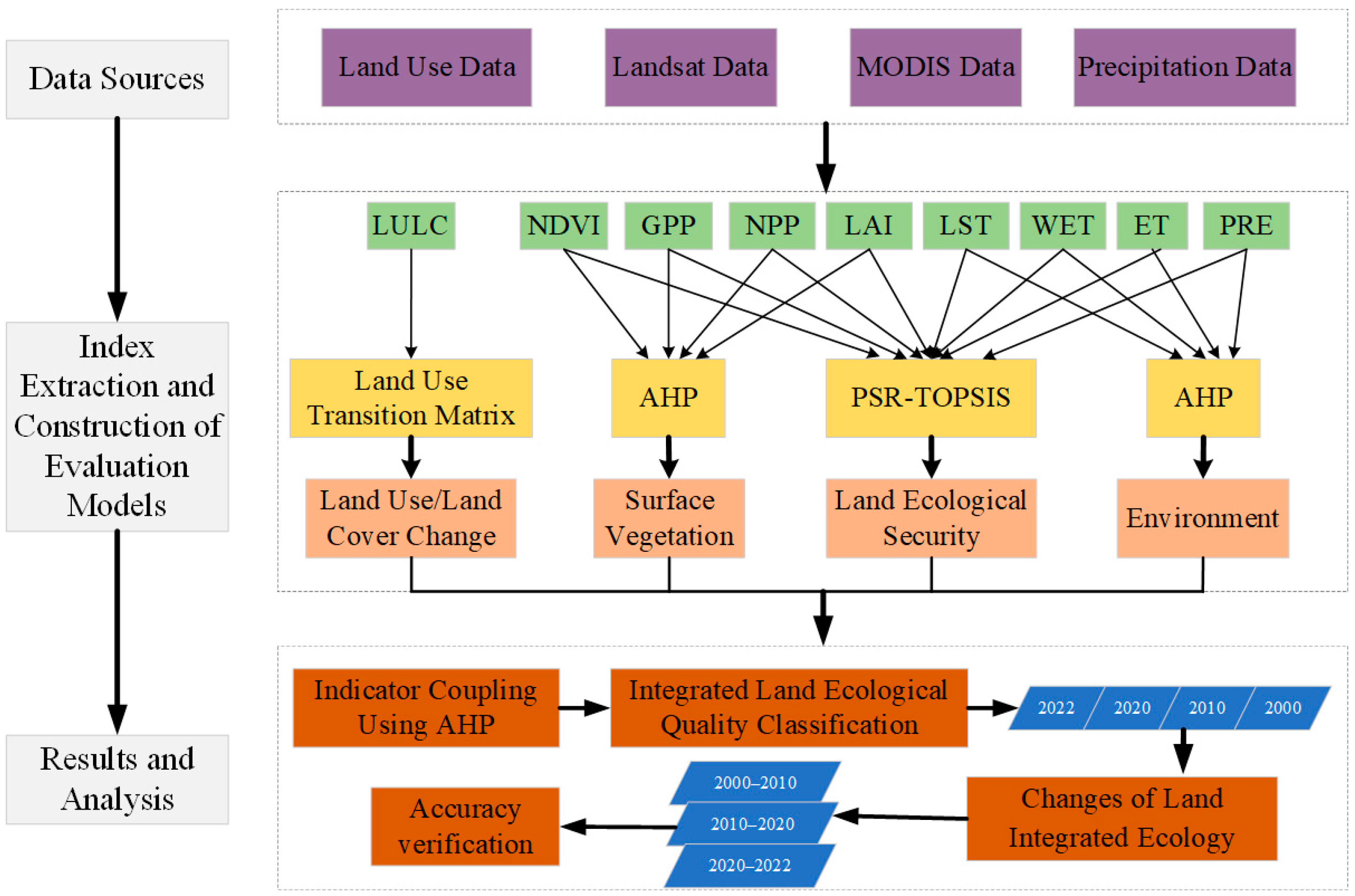
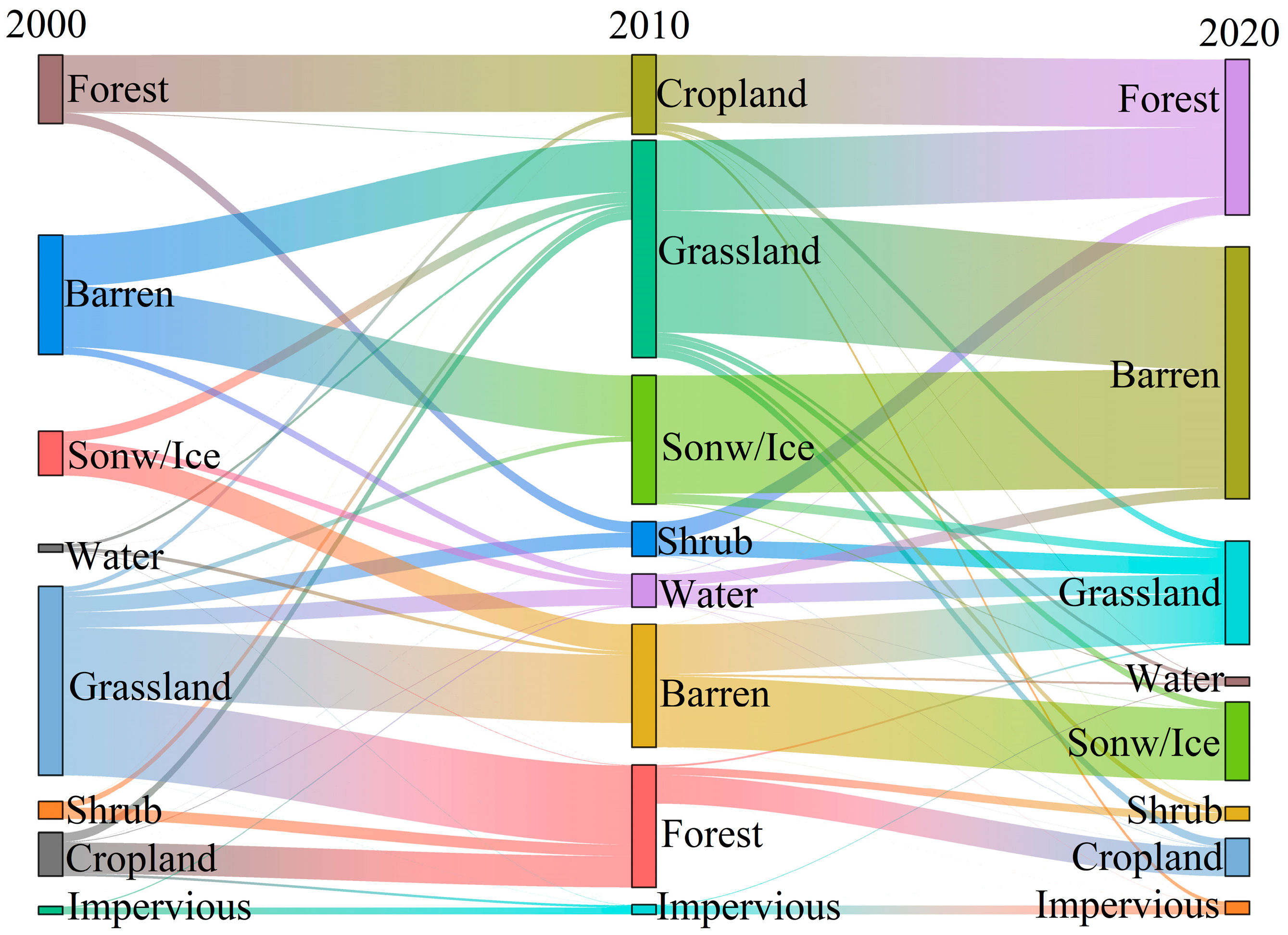



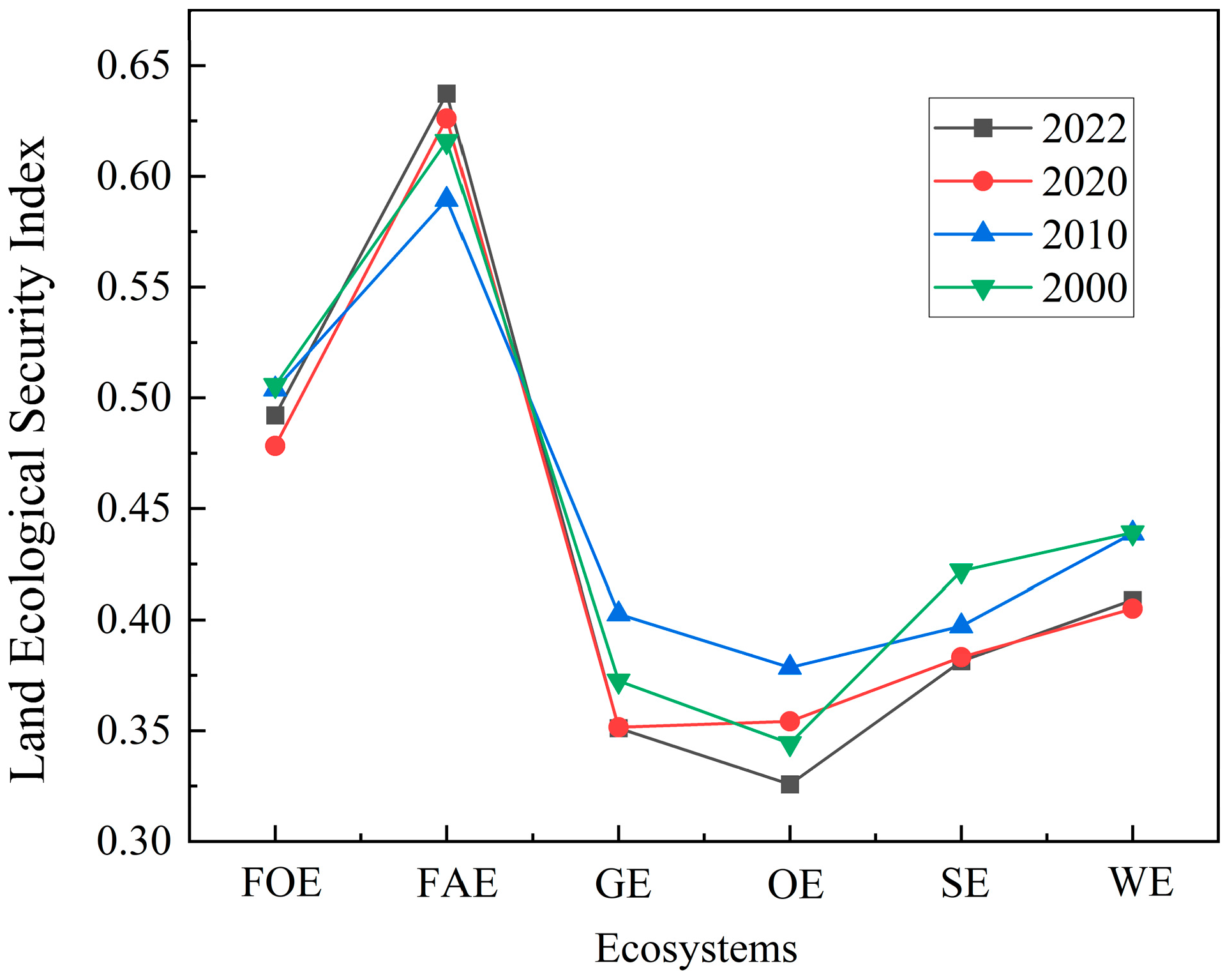




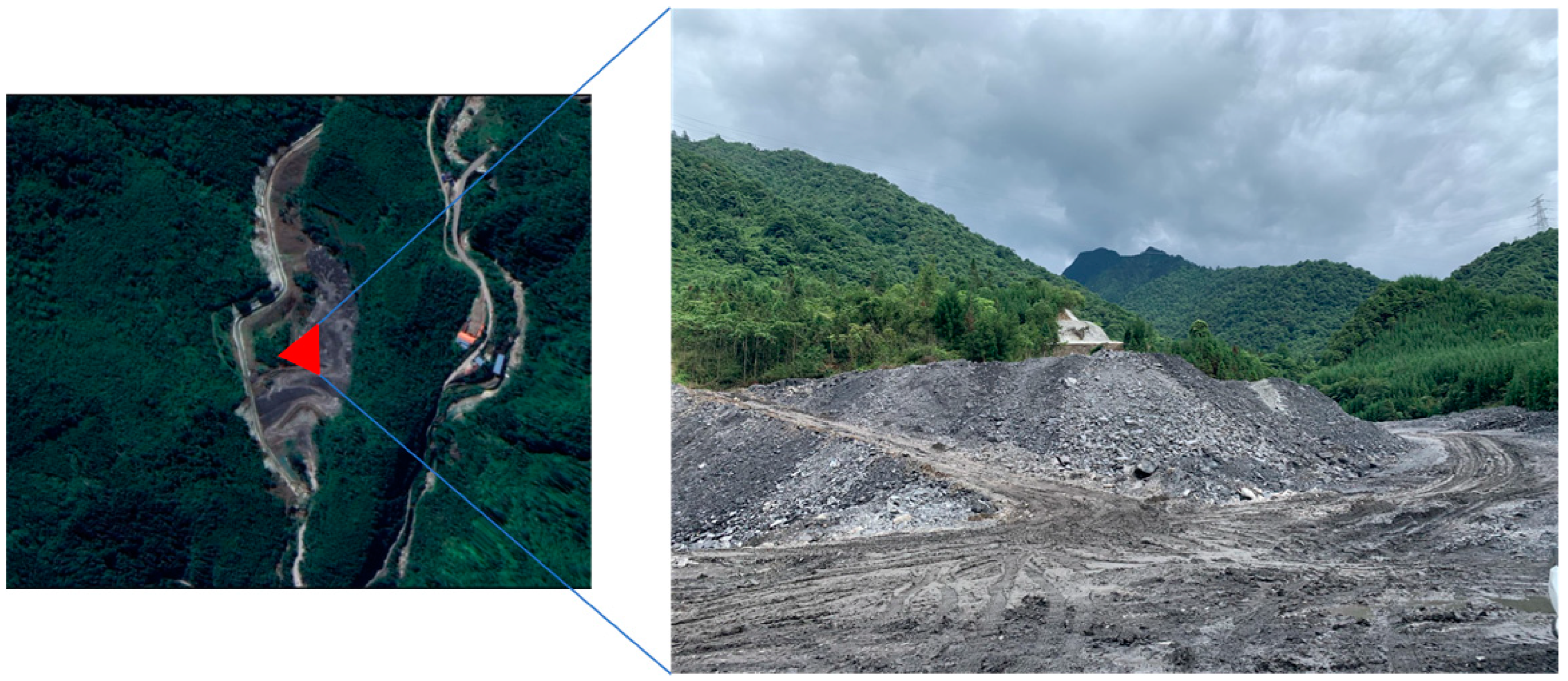
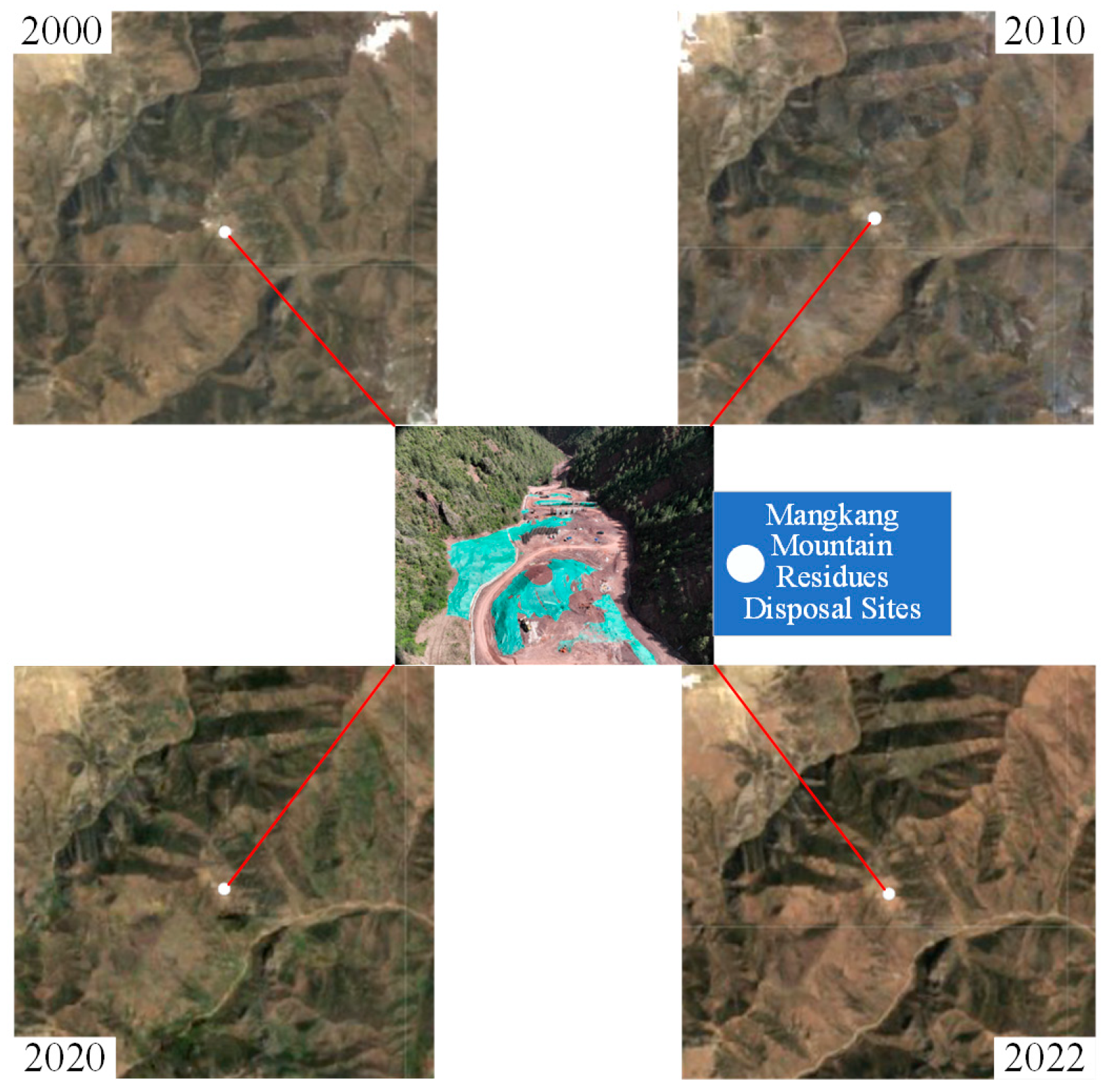
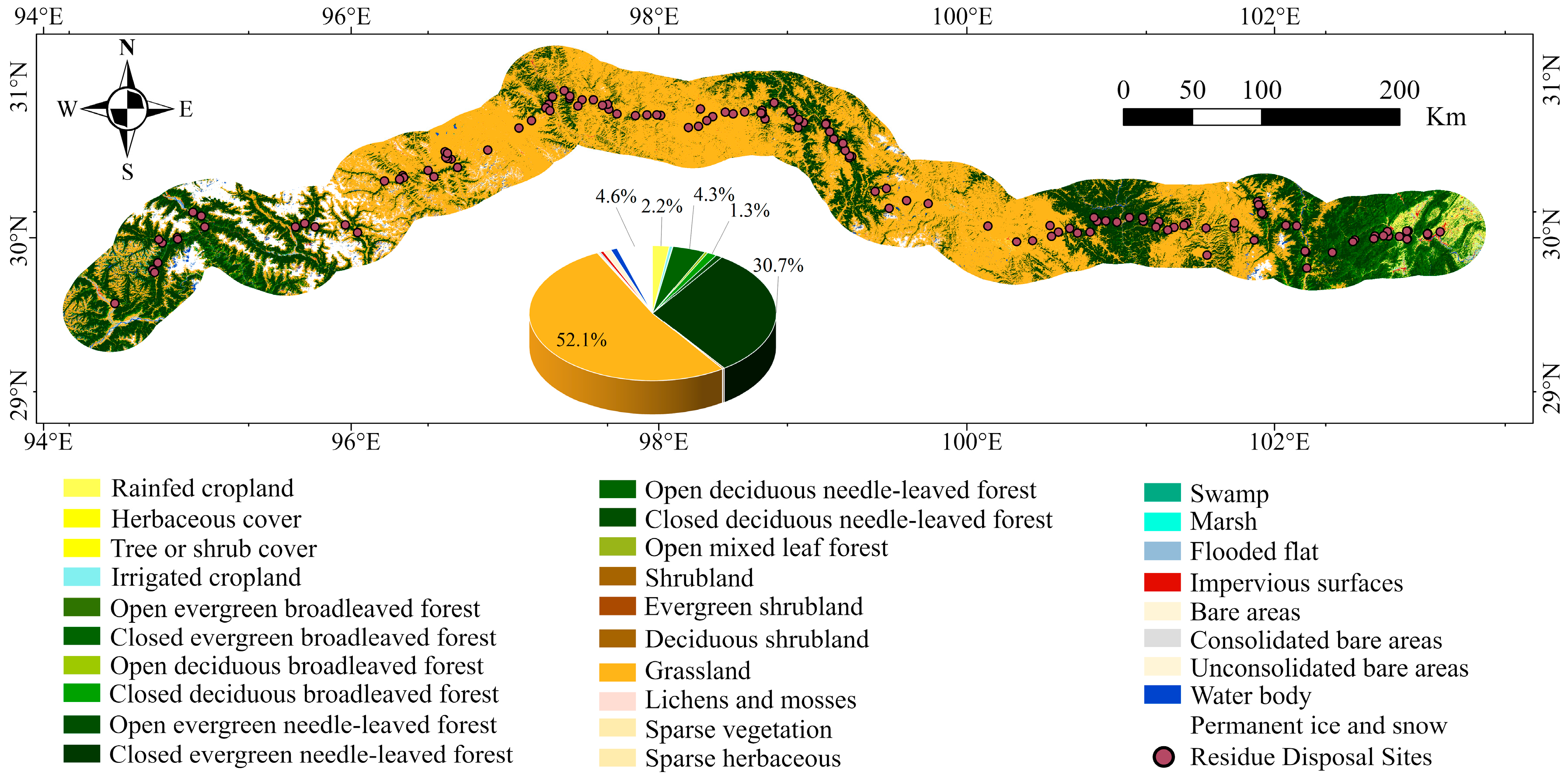
| Product Dataset | Name | Temporal Granularity | Period | Resolution |
|---|---|---|---|---|
| NPP | MODIS/061/MYD17A3HGF | 8-day interval | 2000–2010–2020–2022 | 500 m |
| GPP | MODIS/061/MYD17A3HGF | 8-day interval | 500 m | |
| LAI | MODIS/061/MYD15A2H | 8-day interval | 500 m | |
| ET | MODIS/006/MOD16A2 | 8-day interval | 500 m | |
| LST | MODIS/006/MOD11A1 | Daily | 1000 m |
| Score | Meaning |
|---|---|
| 1 | Equally important |
| 3 | Moderately important |
| 5 | Strongly important |
| 7 | Very strongly important |
| 9 | Extremely important |
| 2, 4, 6, 8 | Intermediate values between the preference |
| Classification | Reference | |||||
|---|---|---|---|---|---|---|
| Surface vegetation index classification | ||||||
| Rating | Very high | High | Middle | Low | Very low | Khan et al. [37] |
| Index range | 1–0.7 | 0.7–0.4 | 0.4–0.25 | 0.25–0.15 | 0.15–0 | |
| Environmental index classification | ||||||
| Rating | Very high | High | Middle | Low | Very low | Xiong et al. [38] |
| Index range | 1–0.7 | 0.7–0.5 | 0.5–0.3 | 0.3–0.15 | 0.15–0 | |
| Land ecological security classification | ||||||
| Security | Safe | Generally safe | Basically safe | Less secure | Unsafe | Ghosh et al. [39] |
| Index range | 1–0.8 | 0.8–0.6 | 0.6–0.4 | 0.4–0.2 | 0.2–0 | |
| Land ecology index classification | ||||||
| Rating | Very high | High | Middle | Low | Very low | Liu et al. [13] |
| Index range | 5–3.7 | 3.7–3 | 3–2.5 | 2.5–1.5 | 1.5–0 | |
| 2000\2010 | Cropland | Forest | Shrub | Grassland | Water | Snow/Ice | Barren | Impervious |
| Cropland | 1569 | 186 | 1 | 52 | 5 | 0 | 0 | 14 |
| Forest | 334 | 19,554 | 63 | 5 | 0 | 0 | 0 | 0 |
| Shrub | 1 | 68 | 151 | 35 | 0 | 0 | 0 | 0 |
| Grassland | 29 | 467 | 89 | 33,501 | 95 | 31 | 402 | 1 |
| Water | 1 | 3 | 0 | 18 | 245 | 0 | 22 | 2 |
| Snow/Ice | 0 | 0 | 0 | 61 | 43 | 2213 | 159 | 0 |
| Barren | 0 | 0 | 0 | 298 | 44 | 362 | 1854 | 0 |
| Impervious | 0 | 0 | 0 | 0 | 7 | 0 | 0 | 39 |
| 2010\2020 | Cropland | Forest | Shrub | Grassland | Water | Snow/Ice | Barren | Impervious |
| Cropland | 1463 | 399 | 2 | 43 | 4 | 0 | 0 | 23 |
| Forest | 171 | 20,049 | 47 | 12 | 0 | 0 | 0 | 0 |
| Shrub | 2 | 104 | 98 | 101 | 0 | 0 | 0 | 0 |
| Grassland | 48 | 412 | 34 | 32,687 | 23 | 42 | 723 | 0 |
| Water | 3 | 3 | 0 | 109 | 255 | 2 | 66 | 1 |
| Snow/Ice | 0 | 0 | 0 | 56 | 6 | 1843 | 701 | 0 |
| Barren | 1 | 1 | 0 | 292 | 13 | 420 | 1711 | 0 |
| Impervious | 0 | 0 | 0 | 0 | 4 | 0 | 0 | 51 |
Disclaimer/Publisher’s Note: The statements, opinions and data contained in all publications are solely those of the individual author(s) and contributor(s) and not of MDPI and/or the editor(s). MDPI and/or the editor(s) disclaim responsibility for any injury to people or property resulting from any ideas, methods, instructions or products referred to in the content. |
© 2024 by the authors. Licensee MDPI, Basel, Switzerland. This article is an open access article distributed under the terms and conditions of the Creative Commons Attribution (CC BY) license (https://creativecommons.org/licenses/by/4.0/).
Share and Cite
Ji, C.; Yang, H.; Pei, X.; Zhang, X.; Chen, L.; Liang, D.; Cao, Y.; Pan, J.; Chen, M. Dynamic Integrated Ecological Assessment along the Corridor of the Sichuan–Tibet Railway. Land 2024, 13, 857. https://doi.org/10.3390/land13060857
Ji C, Yang H, Pei X, Zhang X, Chen L, Liang D, Cao Y, Pan J, Chen M. Dynamic Integrated Ecological Assessment along the Corridor of the Sichuan–Tibet Railway. Land. 2024; 13(6):857. https://doi.org/10.3390/land13060857
Chicago/Turabian StyleJi, Cuicui, Hengcong Yang, Xiangjun Pei, Xiaochao Zhang, Lichuan Chen, Dan Liang, Yiming Cao, Jianping Pan, and Maolin Chen. 2024. "Dynamic Integrated Ecological Assessment along the Corridor of the Sichuan–Tibet Railway" Land 13, no. 6: 857. https://doi.org/10.3390/land13060857
APA StyleJi, C., Yang, H., Pei, X., Zhang, X., Chen, L., Liang, D., Cao, Y., Pan, J., & Chen, M. (2024). Dynamic Integrated Ecological Assessment along the Corridor of the Sichuan–Tibet Railway. Land, 13(6), 857. https://doi.org/10.3390/land13060857









